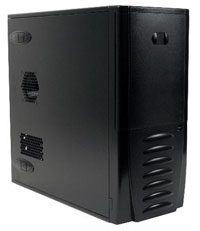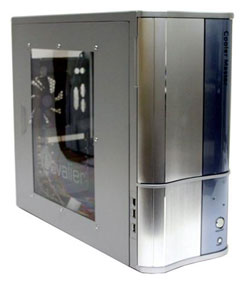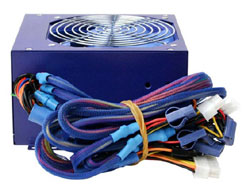Buyer's Guide - Mid-Range, January 2005
by Jarred Walton on January 21, 2005 11:09 AM EST- Posted in
- Guides
Case and Power Recommendations
We've got all the internal components picked out now, so all that's left is the choice of case, monitor, and a few other external parts. Preference for case design can vary wildly from person to person, so if you have a favorite case, you should get that. A lot of us prefer the clean, elegant looking cases as opposed to models that have a lot of bling-bling, so that's what we'll recommend. Besides, those who really like the bling are better off modding their cases for a truly unique look. We also like quiet cases where possible, although silence and high performance are nearly impossible to achieve at the same time. Finally, for most mid-range and above configurations, you really need a decent power supply to ensure maximum stability - and for that matter, a battery backup is also a good idea. You could try to get a case with a decent power supply included - the Antec cases that we frequently recommend are sufficient for the basic setup - but that really limits your choice of case. We prefer to look at all options and just plan on adding a better power supply - and if you're seriously considering the SLI configuration, don't even think about getting by with a cheap PSU!
Case Recommendation
Antec SLK-3000-BPrice: $76 Shipped
If that case looks familiar, we're not surprised. We've recommended the 3700-BQE as well as several other BQE Antec models in many of our recent Guides. They include decent power supplies and have a reasonable price, all things considered. The 3000-B is a newer addition that builds off the 3700, only without a power supply. This is a great starter case, and it is very easy to set up initially as well as upgrade over time.
There are a few minor differences between this model and the 3700. First, it includes a cooling duct that allows the CPU fan to draw in cool air directly from outside. There are ventilation holes on the left side of the case for both the duct as well as lower down over the expansion card area. The case includes a 120 mm temperature controlled fan in the rear - a fan that is very close to silent - and there is room to add another 120 mm fan in front of the hard drive bays. Rather than slots for four hard drives with a tray, there are five hard drive slots. We're not sure if we like the loss of the trays, as they do make it easier to temporarily remove the drives. Overall, though, we like the modifications, even if they're not terribly important in the larger scheme of things. About the only missing feature that some people will want is a front Firewire port.
If you go with the base mid-range configuration that we're recommending in this Guide, you could probably go with the 3700 and get the included 350W PSU for about $20 more, but we recommend the purchase of a more capable power supply. The Antec Sonata is also available for a few dollars more and includes an even better 380W "TruePower" power supply, but it isn't quite as roomy, should you add the second 120 mm fan. For the overclocking/enthusiast configurations, you'll definitely need a better power supply - especially if you actually plan to go for an SLI system during the life of the computer. Our PSU recommendation is below.
Case Alternative
CoolerMaster Cooler Master Cavalier 3, model CAV-T03-WWPrice: $112 Shipped
If you want a case that's a little flashier, we like the CoolerMaster Cavalier. It's available in a couple of different color schemes, with the silver/blue model shown here. It has a case window; front USB, audio, and firewire ports; a rear 120 mm fan; and a steel frame with aluminum front bezel and panels. Expansion options include five 5.25" external bays and four 3.5" bays, one of which is external. All of the bays have a tool-less latching mechanism that works pretty well. The external drive bays are all covered by a door, but there's a catch with this design: the direction that the door opens can be modified. Most doors open to the right, but that doesn't always work for some people, so it's nice to see a case that addresses that concern. Overall, this is a very well constructed case at a reasonable price.
Power Supply Recommendation
Fortron Source Blue Storm 400W, Model FSP400-60THN-RPrice: $59 Shipped
Our choice of power supply comes from Fotron Source, one of the more reliable manufacturers. It has several noteworthy features that put it ahead of competitors. The 120 mm fan helps to reduce the noise levels relative to most 80 mm fans, and it has sheathed cables. Another nice addition is the inclusion of a 24-pin BTX/EPS12V power connector, with a 20-pin ATX power adapter. It's certainly not required for all motherboards, but for the latest Intel models, we prefer to go with a 24-pin connector instead of a 20-pin. It also includes dual 12V rails, which helps to guarantee a sufficient amount of power to components such as hard drives and graphics cards. While 400W may not seem like all that much, we consider this a quality 400W PSU - many lesser brands would rate this as a 500W+ PSU.
Good alternatives from Antec, Enermax, OCZ, Sparkle, Ultra and several others exist, but they all tend to cost a bit more than the Fotron Source PSUs. We've recommended several of these power supplies in past Guides, and the previous recommendations still stand. One item that is missing from this Fotron is the new 6-pin PCIe graphics power connector - two 4-pin molex connectors can be used with an adapter, of course. Some may also find the blue light within the PSU to be a bit distracting, although it's really not so bright that would cause us to worry about it. As an alternative, check out the OCZ ModStream and PowerStream PSUs; they cost a lot, but their warranty and reliability is very good. A more powerful PSU would definitely be recommended for SLI setups.













46 Comments
View All Comments
JarredWalton - Wednesday, January 26, 2005 - link
^^^ Er, Foxconn is at MonarchComputer.com, not GameVE.JarredWalton - Wednesday, January 26, 2005 - link
44 - This was written by January 18th and published Jan 21st. Things change rapidly, which is why the Buyer's Guides are really just a snapshot in time. There are several NF4 boards now available at Newegg, including the Chaintech and an MSI Neo4 Platinum. Odd that the Chaintech lists "NVIDIA 7.1-channel audio" - is SoundStorm back with NF4? I don't think I had heard about that. The Gigabyte board is also available from quite a few other resellers besides Newegg, of course. There's even a $109 Foxconn NF4 board at GameVE. Interesting! Not that I've had any good Foxconn experiences, but $109 is attractive.jleandro - Wednesday, January 26, 2005 - link
Don't want to be a pain, you guys review whatever boards you think are worthy, but I just checked Newegg and here's what they had IN STOCK:CHAINTECH NVIDIA nForce4 Ultra Chipset Motherboard For AMD Socket 939 CPU, Model "VNF4/Ultra" -RETAIL US$ 135
MSI "K8N Neo4 Platinum" NVIDIA nForce4 Ultra Chipset Motherboard For AMD Socket 939 CPU -RETAIL US$ 159
GIGABYTE "GA-K8NXP-SLI" NVIDIA nForce4 SLI Chipset Motherboard For AMD Socket 939 CPU -RETAIL US$ 249
ASUS "A8N-SLI Deluxe" nForce4 SLI Chipset Motherboard For AMD Socket 939 CPU -RETAIL US$ 265
Interesting that the Gigabyte K8NF-9 was actually not in stock.
hawksballer - Tuesday, January 25, 2005 - link
JarredWalton - Monday, January 24, 2005 - link
41 - Guide editors changed a few months back. The "alternative" configurations have always been more expensive, and they include *all* the alternatives, usually. If you were to take this Guide's alternative (NF4) and stick with the recommend parts everywhere else, price would drop considerably. I haven't made a point of highlighting this, but I did change the pricing targets a bit on the Guides.For the budget, I typically try for $500, but I usually end up closer to $600. Compromises to drop the price are possible but undesirable, i.e. go with 1x256 MB of RAM. The Budget altenative I generally target slightly below the Mid-Range, so $900 to $1000 is usually where it lands.
The Mid-Range has been bumped to $1250 by default, which generally allows for a very good all-around system with few (if any) compromises. The alternative Mid-Range I try to keep under $2000, although closer to $1750 is desirable.
I haven't done any High-End or OC Guides, but High-End will be in the $2000+ range (maxing out at $4000 or so with *all* the trimmings), and the OC Guide is really just about any of the above price goals. I'm working on one of those.
Hopefully that answers your questions. If you want to trim costs a bit on the Mid-Range, going to a slower CPU and GPU usually cuts close to $200, but then it's no longer an all-around system.
-------------
#40: The Chaintech may very well be available in Hungary, but it is not at all available in the US right now. Newegg is the one of the few sites that even list it, and any boards have disappeared *FAST*. If you picked on up without difficulty where you live, more power to you! Lucky #@$^&*%! ;)
wilburpan - Monday, January 24, 2005 - link
Is it just me, or have the Mid-Range and Entry Level Buyer's Guides suffered from price inflation? It seems to me that way back when, the price points for these two were a solid $1000 and $500, respectively. Now the Entry Level Guide has a budget of up to $1000, while the Mid-Range Guide is pushing $2000.I can understand that picking price points is an arbitrary process, but I would think that for comparing what your computer dollar buys you over tme, it would be nice to remain consistent.
jleandro - Monday, January 24, 2005 - link
Can't understand why the Chanitech NF4 Ultra Zenith is not considered to be available.I live in Hungary (not the prime tech spot) and this board has been available for some time, most retailers have it.
In fact I just bought one today for ~110 USD and will pick it up tomorrow.
For instance, check http://www.e-connect.hu under "alaplapok" (motherboard in Hungarian).
JarredWalton - Monday, January 24, 2005 - link
38 - Thanks. It's corrected now. The marketing for the drive states "with SATA-II features" and somewhere along the line that got put in as SATA-II. :| Basically, the drive has hot-swap capability and NCQ, which are both SATA-II. It does not support 300MB/s, but then burst transfer rates really matter much. With sustained transfer rates of even the fastest drives maxing out around 70 MB/s, it will be quite some time before SATA-II transfer rates really show real-world benefit.37 - 0dB computing? I'm not sure I'm the one to address that, but it's certainly something to think about. I'll pass that along and see if we can acquire the parts for such a test. They're relatively expensive in comparison to fan-based solutions, unfortunately.
AnnihilatorX - Monday, January 24, 2005 - link
JarredWalton:A misleading information I just found and thought would like to point out...
The Maxtor Diamond Max 10 300GB with NCQ 16MB cache (6B300S0) is SATA-I/150 in terms of transfer speed, but not SATA-II/300 as stated in page 6.
http://www.anandtech.com/guides/showdoc.aspx?i=232...
"Maxtor 300GB SATA-II with NCQ and 16MB cache"
ceefka - Monday, January 24, 2005 - link
Again a great guide. I was already interested in the Maxtor 300 GB SATA II. I guess in that case you'll have to go with the Gigabyte GA-K8NF-9 or any of the other nForce 4 boards.Would it be a challenge for AT to build a 0dB PC with high end components with Intel and AMD and compare notes. This machine should at least be a mid-range performer or just as high as you can go on 0dB.
I wonder because I'd like to build something really quiet. I have already looked into components like Yesico FL420 and fanless CPU coolers, but I am not sure if all of that will work with also two Maxtor 300GB SATA-II's in http://www.blacknoise.de/shop/de_DE/produkte/id_is...